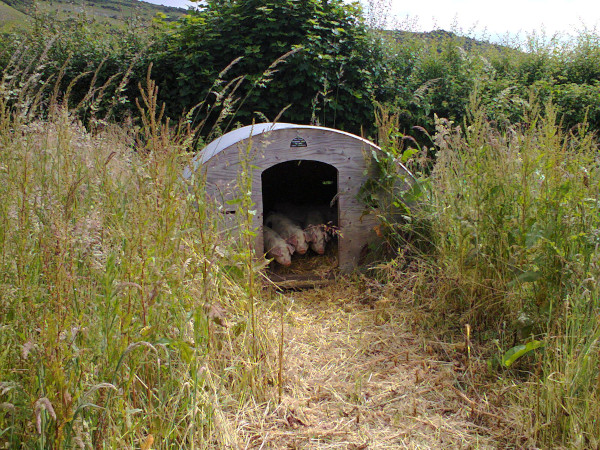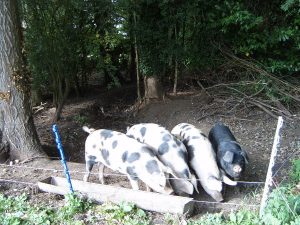In 2012 some households in our village decided to start a pig co-op/club. Living in a Somerset village and with several interested neighbours, one of whom had the space needed, we all got together for an informal meeting to discuss the idea and see if we could agree on a few rules (first rule of Pig Club: talk about Pig Club).
For example, it was important to me and my hubby that the pigs were fed organically; all households felt they should have plenty of space to roam and root, that they had a wallow and an ark to sleep in. Others weren’t that bothered about the feed but were happy to go organic as long as it wasn’t too expensive.
Make your rules
Our four households ranged from retired professional couples to a family of five on a budget, so it was necessary to be clear about costs. These are the rules we came up with. First, welfare of the pigs takes priority: if anyone thinks a pig is unwell, they call in another member of the co-op to have a look, and if they concur, we phone our “pig mentor”, a woman who lives in the next village and has been tremendously helpful. If she thinks it needs the vet, then the vet is called. Often though, she can advise us what to do; we haven’t had any serious illnesses or emergencies so far. Second: we all take turns to do a week’s pig feeding via a rota. Third: if any strimming, fence-mending or other maintenance needs doing, we all pitch in and do it. Fourth: we all keep account of expenditure we’ve made and at the end of the co-op we do our sums and sort out who is owed what. See here for lots of useful advice.

Last year’s Berkshire pigs – just because they’re cute.
Registering with Defra
The place where you keep the pigs must be registered with Defra: you get a County Parish Holding Number and there is a small amount of paperwork to fill out. When the pigs arrive they won’t have ear tags but you must put these in before the pigs go to slaughter as the tag numbers are recorded. We tend to tag our pigs the day before they go and it’s very easy; they hardly notice it as we do it while they are eating. See here for much helpful information on this.
Medication
I’m personally not keen on my animals having chemical treatments but the rest of the co-op members don’t mind and I’m happy to go along with that. For example, this year the piglets arrived with baggage in the form of lice. The standard treatment is an injection that kills lice and worms at the same time. We got the kit and did the pigs ourselves, but the lice were still there a couple of weeks later so we got the vet out to do it. This cost 75 quid but we learned how to do it properly next time. Note: if your pigs have parasites at slaughter time the abattoir won’t take them, so it’s important to keep on top of this.

Our pigs lying under their sunshade.
Costs
Costs include buying the piglets, feed, vet bills, straw, electric fencing, slaughter and butchering, buckets etc, although of course some of these are one-off costs so only apply in the first year. We buy our piglets at 8 or 10 weeks old, from a reputable breeder and thus far have kept Tamworths, Berkshires and Gloucester Old Spots. They cost between 30 and 40 pounds per piglet and the breeders have been happy to deliver them. Sometimes they charge for that, sometimes not. I think they like to come and see our set-up, as they care about their animals and, after all, we are amateurs. So far they have been approving! For 2013 we worked out that our meat came in at a total cost of around £3.70 per kilo. A quick chat with Mr Google showed that supermarket ordinary factory-farmed pork shoulder was £6.99/kg, Waitrose free range shoulder was £8.89/kg, and organic farms around £13.00/kg.
The end is nigh
Every Friday we have pig changeover, when we all meet at the pig pen to swap feeding duties, look at the pigs, chat and have a drink. The pigs go to slaughter at about 6 months old (if you want bacon you keep them for a bit longer) to a small local abattoir. Their butcher asks for a list of what joints and cuts we want, and then we go along and collect the meat in vacuum-sealed bags. Hubby and I are very fond of sausages so took some of our meat to a local butcher, who made the sausages to a traditional recipe that didn’t include any nitrates or e-numbers and very little filler (eg rusk to help bind the mix). I can honestly say they are the best sausages I’ve ever tasted. This year we are five households but we decided to get six pigs, so that we sell the meat from the spare to cover costs. Although this has meant buying more feed, that will be offset by the money we get for the meat (already allocated to family and friends), so our costs will be much lower.

Last year’s Berkshires again.
Feeding
Regarding food, there are strict laws as to what you can and can’t feed to pigs. It is against the law to feed pigs anything that comes out of a kitchen. This carries a penalty of up to two years in prison. Given that traditionally people fed pigs on slops and food waste you might think this is bonkers but unfortunately that’s how it is since the foot-and-mouth outbreak of 2001 which was traced back to pigs eating infected meat, albeit in illegally untreated slop (see here). You can however give your pigs garden waste such as fallen apples, bolted lettuces, cabbage leaves etc, and if you have a local fruit & veg shop that gives away damaged produce you can also use that.
Have a go
On the plus side: it’s great fun, it means we get high-welfare, organic meat, the pigs are very happy and contented animals, it bonds our community and we’ve learned so much. On the minus side: you need to like pigs! There could have been a major emergency such as a really sick animal, or some disease that could have infected all the pigs, or they might have been stolen. But those are all fairly unlikely scenarios. If you are interested in starting a pig club/co-op, learn as much as you can about it beforehand, try to have a mentor to whom you can turn for advice and support, make sure you have adequate facilities eg space, housing, fencing etc, and give it a go. It’s not complicated and you won’t be contributing to the perpetuation of animal misery and suffering created by factory farming.

Our latest pigs photographed recently – you can see how they’ve grown and how they’ve removed weeds and dug the ground.




